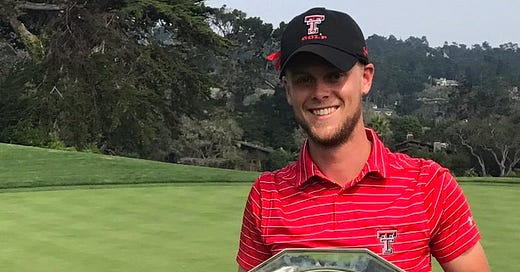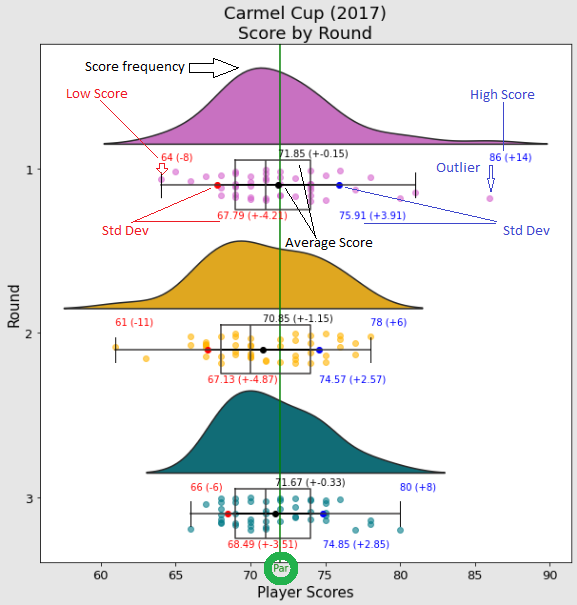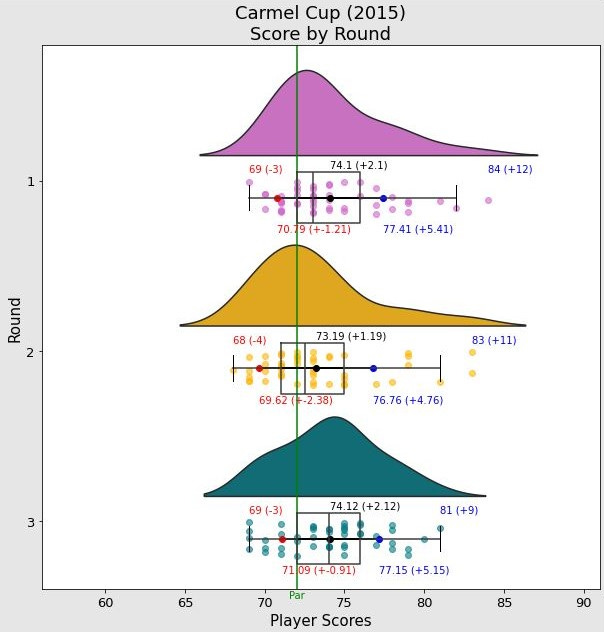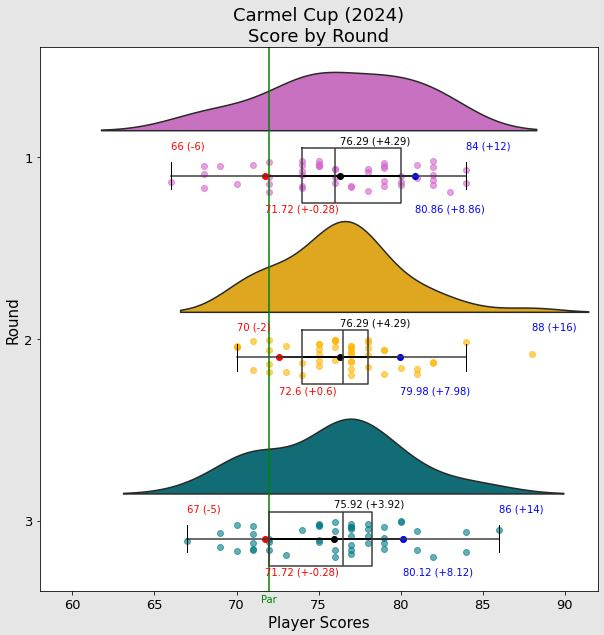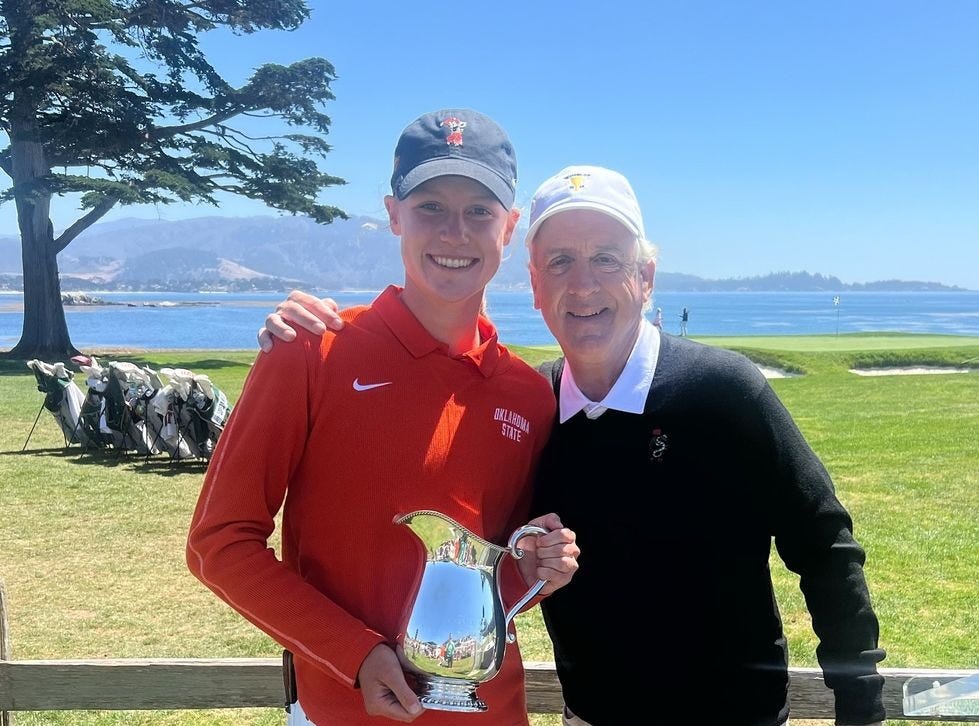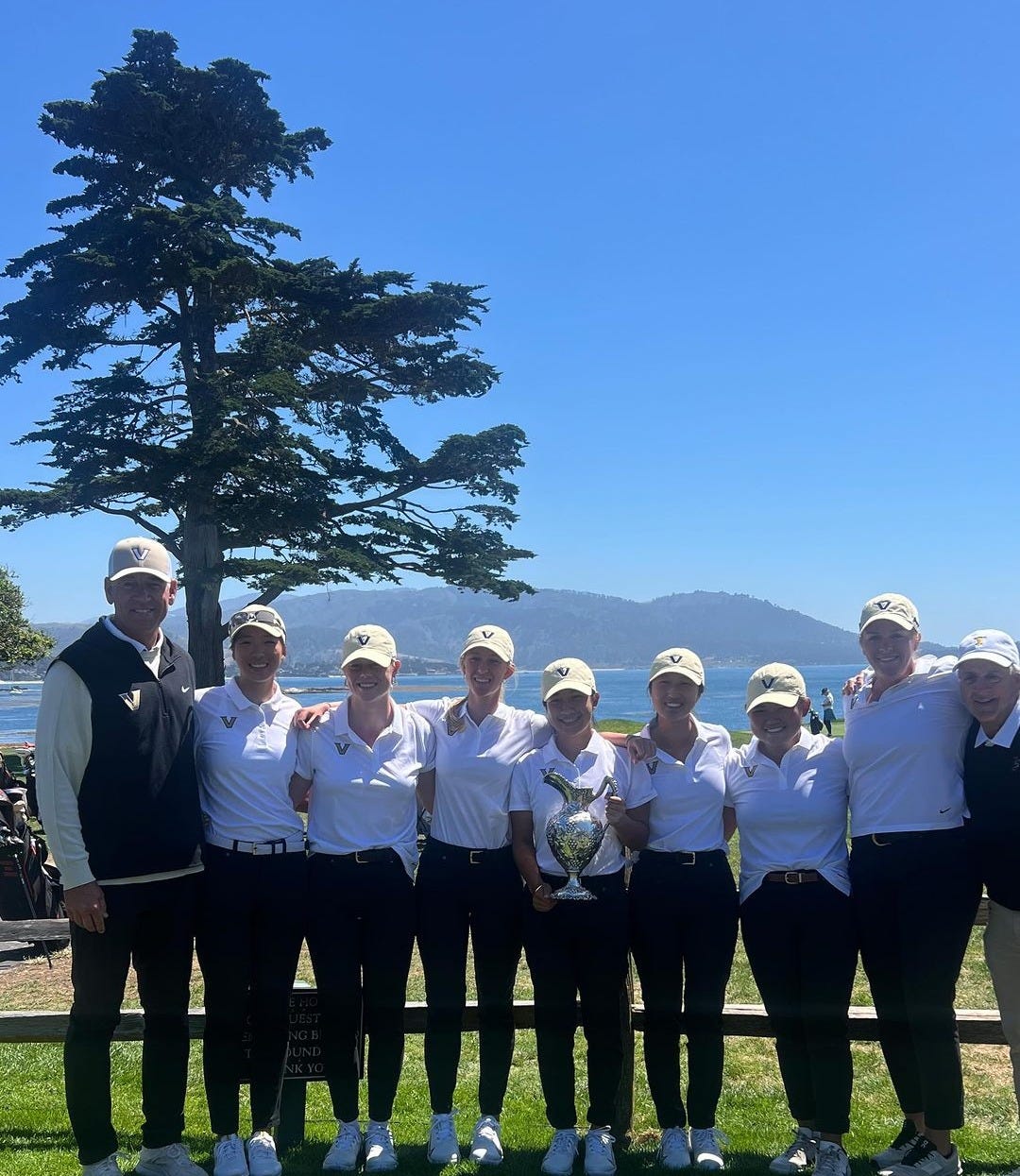This week, David Tenneson of 5count4 (check out his Substack if you like college golf) and I take a deep dive into one of the more unique college golf tournaments on the Fall calendar. The Carmel Cup - which took its name from the Carmel area where the tournament is played - was inaugurated as a men’s event in 2011 and eventually became a women’s event starting in 2022. Along the way, it featured a number of match play formats before settling on the standard 54-hole stroke play format with the twist of adding an extra golfer, making it one of the few 6-count-5 tournaments. Played at an iconic venue, this unique event has been an unforgettable way to start the college golf season for years.
IN THE BEGINNING
There’s no Carmel Cup without Fin Ewing. Finley Ewing III, a Dallas-based businessman, serves as the President and Dealer/Operator of Ewing Automotive Group. Though primarily known for his car dealerships, Fin has been deeply involved in the world of golf for decades. His contributions to the sport earned him a place in the Texas Golf Hall of Fame, where he was inducted as a lifetime achievement honoree.
The Ewing family includes two sons, Finley IV and Charlie. The older son, Finley, began his collegiate golf journey at Texas Tech University in 2008. Two years later, younger brother Charlie joined Vanderbilt, embarking on his own path in college golf.
With sons on different campuses, an idea sparked in Fin Ewing’s mind: to create a unique collegiate experience by inviting their teams to a matchplay tournament at the iconic Pebble Beach. Coaches Greg Sands (Texas Tech) and Tom Shaw (Vanderbilt) embraced the vision, and in 2011, the inaugural tournament took place as a head-to-head matchplay event, featuring rounds at Spyglass Hill and Pebble Beach. Texas Tech claimed victory in this first edition.
The following year, the tournament expanded to four teams. As an alumnus of TCU, Fin naturally invited the Horned Frogs to join. Texas A&M rounded out the roster as the fourth team. Fin’s alma mater were crowned champions that year after a round-robin format. Vanderbilt’s new coach Scott Limbaugh - who was the assistant coach at 2012 NCAA runner-up Alabama - kicked off his career with the Commodores in style, telling the school news ahead of the event:
“I’ve never been to Pebble Beach, so I’m very excited,” said Limbaugh. “It’s obviously a great way to start our season. It’s a reward kind of trip, in my opinion, to travel across the country and play one of the best golf courses in the world. We’re very excited.”
UNLV took Texas A&Ms spot in the field for the 2013 edition of the Carmel Cup, and the new “guests” emerged victorious in what would be the last running of the Carmel Cup that included match play. After 36 holes of stroke play in which Vandy’s Matthias Schwab earned medalist honors, UNLV and Vanderbilt faced off for the title at the beautiful Pebble Beach Golf Club. Playing in his final Carmel Cup, senior Charlie Ewing captured the only full point for the Commodores who fell to the Running Rebels 4.5-1.5.
2014 was the first running of the Carmel Cup as a strokeplay format. The field was expanded to 8 teams. Despite dropping the match play portion, they decided to stick with the unique 6-count-5 format and expanded to the typical (for college golf) 54 holes of stroke play. Furthermore, starting with this event, all rounds were played at Pebble Beach. This was the format and venue used for the next 7 years until the final time played by the men in 2021.
As we can see, the field on the men’s side stayed fairly consistent for the strokeplay-era of the Carmel Cup on the men’s side. The tournament ranked in the top-three strength of field regularly due to the heavy-hitting “regulars” in this field.
FIRST EVENT FOR FUTURE STARS
Thanks to its unique strength of field and its timing over Labor Day weekend, the Carmel Cup at Pebble Beach has become the debut stage for many future stars in collegiate golf. As the opening event of the new season, the tournament draws avid college golf fans who eagerly follow live scoring and social media updates, hungry for the return of collegiate competition.
Notable players to make their collegiate golf debut at the Carmel Cup:
Ludvig Åberg (Texas Tech) | PGA Tour winner, Ryder Cupper
Clement Sordet (Texas Tech) | DP World Tour player
Viktor Hovland (Oklahoma State) | PGA Tour winner, Ryder Cupper
Matthew Wolff (Oklahoma State) | LIV Tour winner & NCAA Champion
Zach Bauchou (Oklahoma State) | PGA Tour player
Sam Stevens (Oklahoma State) | PGA Tour player
Gordon Sargent (Vanderbilt) | Top-ranked amateur in the world & NCAA Champion
Will Gordon (Vanderbilt) | PGA Tour player
Matthias Schwab (Vanderbilt) | DP World Tour/ PGA Tour player
Hayden Springer (TCU) | PGA Tour player
Davis Thomson (Georgia) | PGA Tour player
Brad Dalke (Oklahoma) | Golf YouTuber
Quade Cummins (Oklahoma) | PGA Tour Player
Megha Ganne (Stanford) | All-American & American Curtis Cup member
RED NUMBERS AT THE CARMEL CUP
As previously noted, the Carmel Cup consistently featured a strong field every Labor Day weekend. Reviewing the list of debutants above, it’s evident how much scoring potential this field holds. And beyond these debut players, many other talents have graced the tournament. Ryder Cuppers Wyndham Clark and Sepp Straka, as well as LIV winner Eugenio Chacarra, and PGA Tour winner Austin Eckroat are just a few notable names who have competed at the Carmel Cup.
Besides the high level of competition, Pebble Beach was always set up favorably for scoring during the years I attended the tournament as a coach. In late August and early September, the course is prepped for regular play, given Monterey’s typically mild weather and Pebble Beach’s popularity among golf tourists. The early morning tee times reserved for the Carmel Cup, ahead of green-fee play, ensured softer greens and minimal wind for most of the stroke-play rounds. Additionally, the rough was generally forgiving throughout the course.
When exceptional players are given soft greens, manageable rough, and calm winds, the results can be phenomenal scores, as we’ve seen in this tournament.
THE HISTORIC 61 (Sep 2017)
Mikkel’s account from memory
I had spent the morning walking the course with one of our players who teed off early, so I didn’t see much of Hurly that day. After finishing on the 18th green with Kyle Hogan, I decided to hurry back to the 17th tee to provide yardage and club information to our last three players of the day. The hole was cut all the way back on the right side of the 17th green, nearly brushing the bunker at the back.
Before Hurly’s group approached, I refreshed Golfstat on my phone and saw that he was 9-under. This was my first tournament with the team, so I didn’t know the players well yet. I expected Hurly to be intensely focused, so I positioned myself just off the tee box, not wanting to disrupt his flow but ready to assist if he approached.
To my surprise, Hurly spotted me from about 50 yards away and, with a big grin, headed straight toward me. I was struck by how relaxed he seemed. His group was on the clock, so after a quick greeting, he asked about what yardage and what the other Red Raiders had hit.
Though I don’t remember the exact number, the shot called for either an 8- or 7-iron for Hurly. To my delight, the 8-iron came out of the bag, taking the trouble long out of play. As Hurly pulled the club, I quietly excused myself, and started making my way over the 18th green again. From a distance, I witnessed Hurly’s approach to the 17th come up way short. The 8-iron had covered the from edge of green, probably 60-feet away from the hole.
As I came up to the team gathered around the 18th green, I refreshed Golfstat again. Turns out Hurly had holed that 60-foot putt on the 17th to go the 10-under par.
On the 18th, Hurly made an unconventional choice. Off the tee, he went with his trusty fairway-finder, a low-cut driver, positioning himself near the iconic tree in the middle of the fairway. From there, he kept his 3-wood in the bag, opting instead for a lay-up. While laying up wasn’t unusual, his chosen spot was: Hurly played a long-iron to just 30 yards from the green, stopping short of the bunker guarding the front right side.
With adrenaline pumping as he chased a course record on one of the world’s most iconic courses, most would likely choose a full shot for the third. But Hurly knew his strengths. The pitch was challenging, requiring a precise shot over the bunker to reach a mid-right pin location. He executed beautifully, ending it about 10 feet from the hole. You know the rest—he drained the putt, let out a triumphant fist pump as the ball dropped for a course-record 61. Pure brilliance.
Not only did Hurly’s 61 set a Pebble Beach course record - besting Tom Kite’s 62 at the 1983 Bing Crosby National Pro-Am - it set a school record for the lowest round to par (-11). Ironically, Hurly’s 61 tied the school record low score set by none other than Finley Ewing IV 5 years earlier at the Royal Oaks Intercollegiate (Dallas, TX) a little over a month after the second ever Carmel Cup.
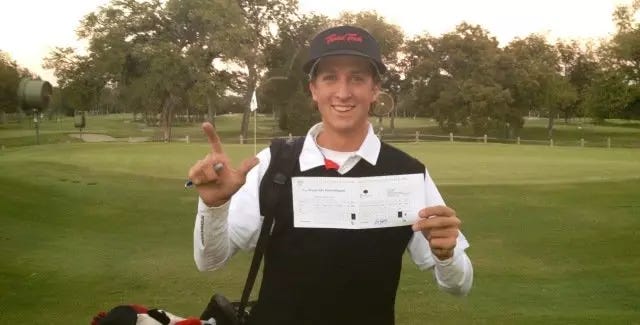
Despite his remarkable 61, Hurly’s follow-up round of 67 led him to a playoff against Hayden Wood for the individual title. On the first playoff hole, Hurly’s steady two-putt for par was enough to secure the victory. Definitely a worthy Carmel Cup champion.
DATA
It’s hard to get a firm grasp of what scores mean in a golf tournament. Obviously a 61 is exceptional no matter what everyone else shoots, but we’re hoping the next couple of graphs can help provide a new and perhaps better way of visualizing the data. Let’s dive into David’s incredible database from the Carmel Cup:
First up is the “rain cloud plot” (with labeling, minus the explanation of a box plot) for the 2017 tournament. The goal here is to show the distribution of scores in a visual way that provides a lot (probably too much) data in a small plot. As Mikkel described above, the course was obviously playing favorably as the field average was under par each round. Even still, this really helps put Hurly’s 61 in perspective with the rest of the field not only for that round, but also the other rounds in that year’s event. Additionally we see how his 67 in the final round was actually really impressive as well despite the scores being more tightly clustered.
Compare that with the 2015 tournament which had the highest scoring of any iteration of this tournament.
The following two graphs combine the men’s 2013-2021 (8 total) tournaments, showing only the positive strokes gained scores (i.e., only the scores better than the field average in any given round). Note that in this case, “Strokes Gained” (SG) is NOT referencing the shot-based values often seen on PGA Tour broadcasts now, but rather a more simple calculation of the field average score - player score; sometimes referred to as “Strokes Gained Total.” As with other forms of SG, a positive value represents a positive result.
The first graph shows the range of each actual (raw) score and how it is better or worse SG-wise depending on how well the field actually shoots. For example, the highest “value” 65 came in the first round of the 2017 tournament when Mason Overstreet [Arkansas] bettered the field average score by 6.85 strokes, whereas the lowest SG-valued 65 came in the second round of the 2018 tournament when Riley Casey [Oklahoma] bettered the field average by only 5.44 strokes; indicating the overall field scoring was better in 2018 round 2 than in 2017 round 1. Again, Hurly’s 61 stands out such that even though scores were much better that year (and round in particular), it was still incredibly great in comparison to the field average. Likewise, that lone 63 was shot by John Augenstein [Vanderbilt] that same round, but we see that it wasn’t nearly as valuable compared to Overstreet’s 65 in the first round.
Lastly, we see the best SG value from each round 2013-2021, which is really just another way of seeing the low round of the day with the added comparison to the field average. The biggest drop off from one round to the next comes from round two to three in 2017 - Hurly’s 61 in round two and Hayden Wood’s [Ok St] 66 in round three - but notice that 2021 had a pretty dramatic drop from Aman Gupta’s [Ok St] 66 in round two to five different players shooting 67 in round three.
WOMEN’S EVENT
After graduating from Vanderbilt in 2014, Charlie Ewing returned in the Spring of 2016 as a volunteer assistant coach for the Commodores. In that role he helped head coach Limbaugh and assistant coach Dusty Smith - who had been the assistant since 2011 - lead the team to a 2016 NCAA match play appearance. The next season (2016-17), Ewing served as the volunteer assistant coach at Texas Tech under Head Coach Greg Sands. Dusty Smith was hired as the men’s head coach at Mississippi State to being the 2017-18 season, and he in turn hired Ewing to be his assistant coach. The next season, the pair brought Miss State to the Carmel Cup for the first time, and they returned again in 2019.
Following the shake up from the COVID19 pandemic that brought a premature end to the 2019-20 season and prevented many teams from playing in the first half of the 2020-21 season (note the Carmel Cup was one of those cancelled events), Ewing was hired on as the Miss St women’s head coach in December 2020. The 2021-22 season marked the final time the Carmel Cup was a men’s event. In 2022, Fin Ewing welcomed his son back to the Carmel Cup as the Lady Bulldogs and seven other teams continued the tradition of the incredible Fall 6-count-5 stroke play event at Pebble Beach.
MORE DATA
This rain cloud plot from the 2022 tournament may be one of my (David’s) favorite of this whole event as it shows just how wildly different the field scoring was across the three rounds. After a widely dispersed set of scores in the first round, the second and third rounds were much more tightly bunched with an extreme outlier in different directions.
Jennie Park’s [Texas A&M] first round 66/-6 marked a fantastic start to the 2022 tournament. That outstanding 63 in the second round came from none other than Stanford legend Rose Zhang, setting a new mark for highest SG round in this event. Proving the point that raw scores don’t tell the full story, Miss St’s Julia Lopez Ramirez would also break through the 10+ SG barrier with her 66 this year (2024).
Stanford dominated the 2022 tournament in a way that none of the men’s teams had in the history of this tournament. The 2017-18 Oklahoma State men’s team started out their historic season with a resounding victory at the Carmel Cup, shooting -52 as a team! That total works out to be an incredible average score of about 68.53/-3.47 per player per round, which was nearly 2 full strokes per player per round better than the field average (aka: Team Strokes Gained Differential). The 2022-23 Stanford women’s team also had a monster year beginning with a Carmel Cup win. Even though their scoring was not nearly as low as Ok St’s, it was better in comparison to the field average by over half a stroke per player per round.
CARMEL CUP 2024
After record-setting low scoring in 2023, the 2024 tournament showed how tough Pebble Beach can play. Not a single team posted an under-par round as those were few and far between for even the individuals.
Grace Kilcrease of Oklahoma State, the recent transfer from Tulsa who had spent a mere week with the team before the tournament, was one of only three players to shoot even par or better each of the three rounds. Her final round 69 was good enough to earn a one stroke victory as she finished at 209/-7.
Vanderbilt got its first win at this event after a strong 363/+3 finish vaulted them up two spots on the leaderboard for a close two stroke victory over Arkansas. Coach Greg Allen has been the Vandy women’s head coach since Charlie Ewing was in school playing on the men’s team, and his heart-felt words at the end of the tournament showed just how special this win was considering his closeness with the Ewing family.
We hope you enjoyed getting to know more about this fantastic event! We intend to do more of these deep dives soon. Let us know what tournament you’d like to see covered and if there’s any stats or data topics you’re curious about.
Have a great week!
If you’d like to support my work further, please consider becoming a paid subscriber. In addition to supporting my writing and website work, paid subscriber get access to all of the player development tools on www.mikkelgolf.com. The tools available include a library of performance drills and on-course formats, plus an on-course stats system designed to improve approach play and putting. Five division one golf programs currently use the stats portal. Reach out for more details if you’re interested!
If you enjoy learning more college golf history, consider also subscribing to David’s newsletter


